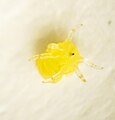| Psylloidea Temporal range: Early Jurassic–Recent PreꞒ Ꞓ O S D C P T J K Pg N | |
|---|---|

| |
| Psylla alni | |
| Scientific classification | |
| Domain: | Eukaryota |
| Kingdom: | Animalia |
| Phylum: | Arthropoda |
| Class: | Insecta |
| Order: | Hemiptera |
| Suborder: | Sternorrhyncha |
| Superfamily: | Psylloidea Latreille, 1807 |
| Families | |
Psylloidea is a superfamily of true bugs, including the jumping plant lice and others which have recently been classified as distinct families. Though the group first appeared during the Early Jurassic, modern members of the group do not appear until the Eocene, and Mesozoic members of the order are usually assigned to the possibly paraphyletic family Liadopsyllidae.
Families
In addition, the following extinct families are recognised:
Economic importance
Some psylloids are economically important pests:
- Diaphorina citri (Liviidae), the asiatic citrus psyllid is native to southern Asia; it has spread to most citrus-growing regions. It is a vector of Liberobacter asiaticum, the bacterial greening disease.
- Trioza erytreae (Triozidae), the African citrus psyllid is a pest of citrus and some other Rutaceae. Like Diaphorina citri it is a vector of "greening disease". The psyllid is primarily an Afrotropical pest.
- Trioza perseae (Triozidae), the avocado psyllid forms galls on the leaves of avocado, Persea americana. Other psyllid pests of avocado include Trioza anceps, Trioza aguacate and Trioza godoyae
- Trioza apicalis (Triozidae), the carrot psyllid is an important pest of the cultivated carrot, Daucus carota (Apiaceae).
- Bactericera cockerelli (syn. Paratrioza cockerelli) (Triozidae), the potato psyllid feeds on potatoes and tomatoes (Solanaceae); sporadic infestations have occurred in potato-growing areas of the USA, causing symptoms knows as "potato yellows".
Gallery
-
 Pachypsylla celtidismamma, galls
Pachypsylla celtidismamma, galls
-
 Pachypsylla celtidisumbilicus
Pachypsylla celtidisumbilicus
-
 Phylloplecta tripunctata, nymphs on Rubus
Phylloplecta tripunctata, nymphs on Rubus
References
- Ouvrard, D. "Psyl'list. An online database dedicated to jumping plant lice". Psyl'list. (in French, English, Spanish, and German)
- Drohojowska, Jowita; Szwedo, Jacek; Müller, Patrick; Burckhardt, Daniel (2020-10-19). "New fossil from mid-Cretaceous Burmese amber confirms monophyly of Liadopsyllidae (Hemiptera: Psylloidea)". Scientific Reports. 10 (1): 17607. Bibcode:2020NatSR..1017607D. doi:10.1038/s41598-020-74551-6. ISSN 2045-2322. PMC 7573606. PMID 33077764.
- Percy, Diana M. "Psyllids of economic importance". www.psyllids.org. Retrieved 11 November 2024.
| Taxon identifiers | |
|---|---|
| Psylloidea |
|
This Hemiptera article related to members of the insect suborder Sternorrhyncha is a stub. You can help Misplaced Pages by expanding it. |